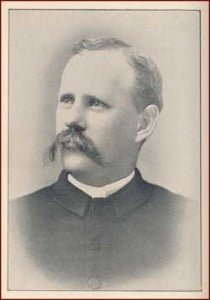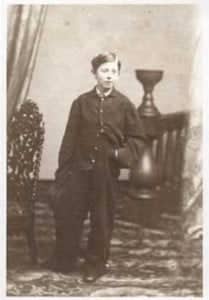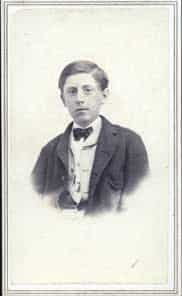 Continuing with our plan to present each Saturday for the remainder of this summer a chapter from the little book PRESBYTERIANISM FOR THE PEOPLE, by the Rev. Dr. Robert P. Kerr. Today we present Chapter II, but also add a bit of biographical introduction regarding the author, the Rev. Robert P. Kerr.
Continuing with our plan to present each Saturday for the remainder of this summer a chapter from the little book PRESBYTERIANISM FOR THE PEOPLE, by the Rev. Dr. Robert P. Kerr. Today we present Chapter II, but also add a bit of biographical introduction regarding the author, the Rev. Robert P. Kerr.
The sixth pastor, Rev. Robert Pollock Kerr, was installed February 3, 1884. Early in his pastorate the work of moving the church from Capitol street to its present location was begun. The last Sunday service was held in the old church April 17, and a farewell prayer meeting Tuesday, April 19, 1884. During the rebuilding period Grace Street and the Second Presbyterian churches, Broad Street Methodist Episcopal Church, and Monumental Protestant Episcopal Church were generously offered for the use of the churchless congregation. Dr. Kerr’s pastorate was the second longest in the history of the church, lasting a little over nineteen years, ending May 25, 1903. Few pastors ever gained the love and admiration of their people or the high esteem of others to a greater extent than did Dr. Kerr while in Richmond. His departure was greatly regretted by all who knew him, and their numbers were legion, for his labors were not confined to his own church. He was always active in every general movement for the spiritual or moral uplift of the city, and was probably the best known minister in Richmond. Throughout his nineteen years service four hundred and twenty-five names were added to the church roll.
Please note too that there may be some understandable quibbles regarding some of Rev. Kerr’s points. For instance, he states that the courts of the church (other than the Session) are composed of equal numbers of ruling and teaching elders. That may have been the case in his denomination and time, but it has not been the practice in all other Presbyterian denominations.
CHAPTER II. — WHAT IS PRESBYTERIANISM?
The invisible Church consists of all God’s true people in heaven and on earth, and the visible Church of all who profess the essential doctrines of Christianity and who are organized for work and for worship, together with their children.
This great visible Church is made up of several denominations holding various views of doctrine, government and worship, having separate organizations and distinguished by many different names, but all professing the essential truth that we are saved by faith in a divine Saviour, Jesus Christ, whose atoning grace is applied to our souls by the Holy Ghost, who renews us, sanctifies us, and prepares us for heaven.
The various denominations have grown out of different crises of Church history, and, whereas many of them started in dissention, God has overruled their existence to the glory of His name and the good of the world; so that, as they stand today, they are unquestionably an advantage, ensuring a continued study of doctrine and the maintenance of purity, and furnishing an incentive to aggressive effort in the redemption of mankind by the preaching of Jesus Christ.
But, whilst we work in separate organizations, we should love one another, and should let charity so conspicuously crown our efforts as to show in spirit a fulfillment of Christ’s prayer that we “might be one.” Thus shall we silence the sneers of the world at our lack of love.
There are two great questions which every denomination must answer: What to do? and How to do it? “What to do?” refers to the preaching of the gospel; “How to do it?” refers to Church government. This second question some answer by saying, “Do it by episcopal modes;” others, “By congregational;” others still, “By presbyterian.” So Church government is simply “how to do it.” “What to do?” is a question upon which we are all substantially agreed—”to preach Christ and Him crucified.” As to “How to do it?” we say, “Do it by presbyterian modes.”
There are only three great principles of Church government: (1) Episcopal, a government by bishops, including Protestant Episcopal, Methodist Episcopal, and Catholic Churches; (2) Congregational, a government by congregations, including the Congregational, Independent and Baptist Churches; and (3) Presbyterian, a government by Presbyteries, including all Presbyterian and Reformed Churches throughout the world. In civil government there are two great systems, the monarchical, or oligarchical, and the republican; these correspond substantially with Episcopalian and Presbyterian. There is and can be, no such thing as a congregational or purely democratic government in the State if it include a large number of citizens. It is a government by the people without any rulers. Monarchy and republicanism, or self-government, have contended together from the beginning, with a gradual advance among the nations toward the latter; and the highest privilege claimed for the people under a republican government is to elect their own rulers. They are therefore called “representative.” Such is the case in the American republic and in others.
Presbyterian Church government is not a form, but a principle; and whereas the applications of this principle will have a strong resemblance, still the exact forms of its development are determined by circumstances. This principle may be briefly stated as follows: PRESBYTERIANISM IS A CHURCH GOVERNMENT BY REPRESENTATIVES ELECTED BY THE PEOPLE AND ALL OF EQUAL AUTHORITY, WHICH IS EXERCISED BY THEM ONLY WHEN ORGANIZED INTO AN ASSEMBLY OR COURT. These representatives are called Elders, or Presbyters, and are of two classes—Ruling Elders, who only rule, and Teaching Elders (or preachers), who both rule and teach. The assemblies, or courts, of the Church are composed of equal numbers of Ruling and Teaching Elders, except in case of the lowest, called the Session, or Consistory, where all except the presiding officer, or Moderator, are Ruling Elders.
These assemblies are arranged in the scale of a regular gradation from the Session, through the Presbytery and Synod, to the General Assembly, which is the highest. These are all Presbyteries, because composed of Presbyters, and had originally the same functions; but for the sake of efficiency and order there has been a distribution of duties, each one having its own province strictly defined. It is the duty of each higher court to review the proceedings of the next lower, and cases are carried from the lowest to the highest. In some parts of the Church minor classes of cases are not allowed to come before the General Assembly, but receive their final decision in the Synod.


